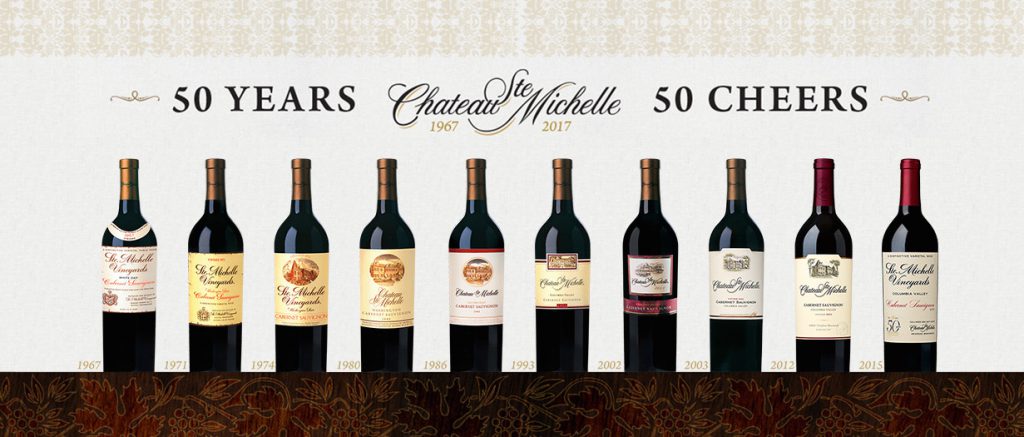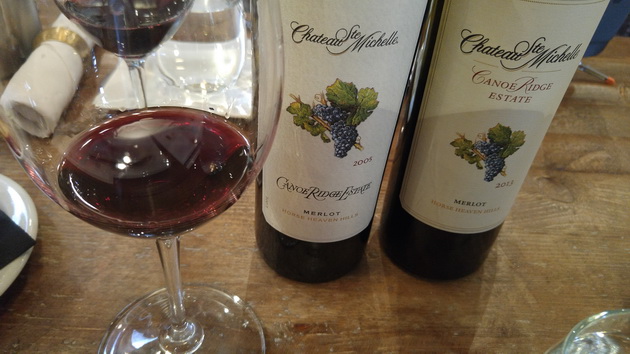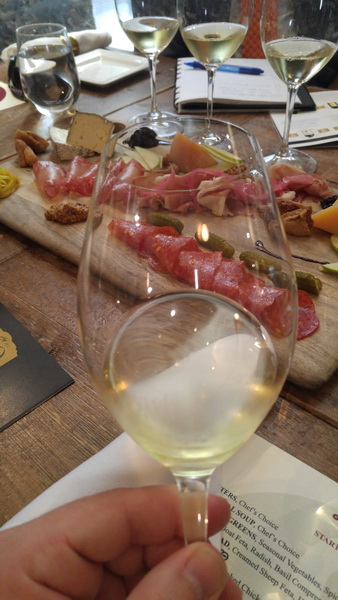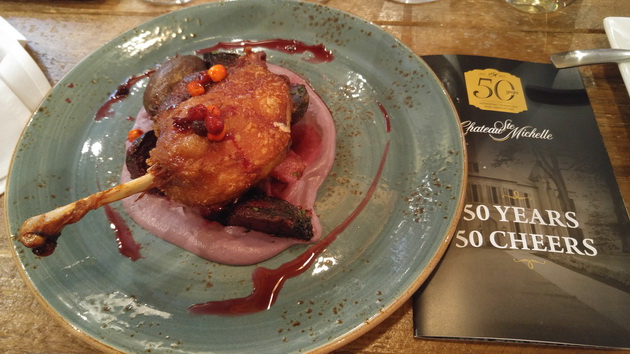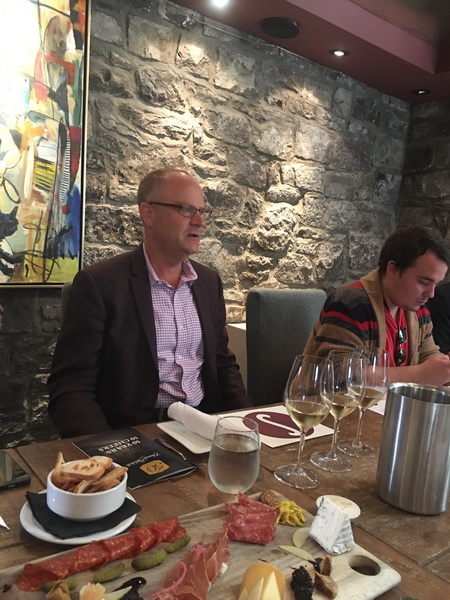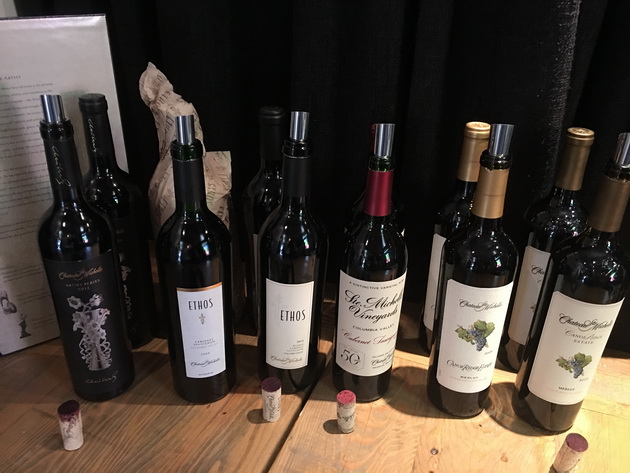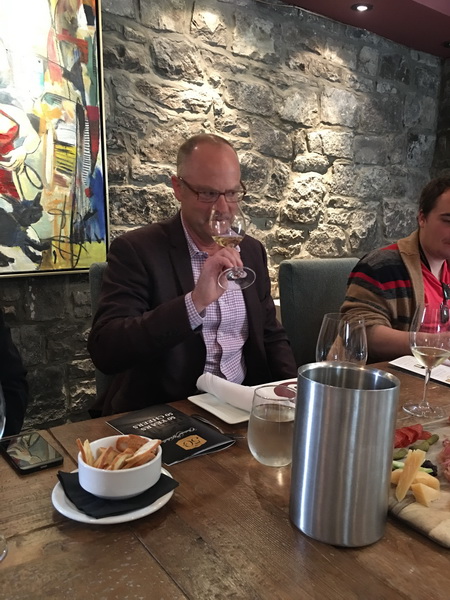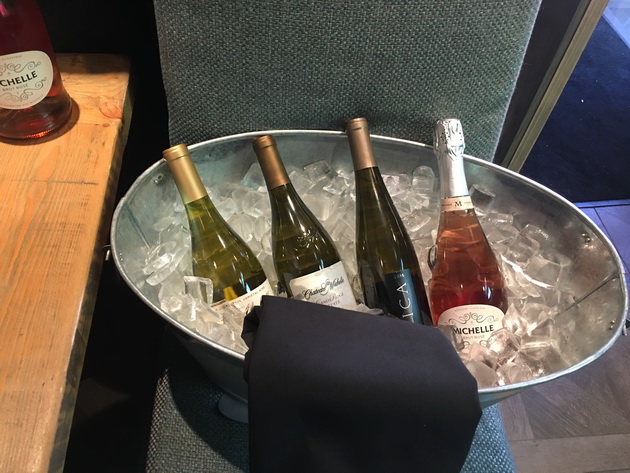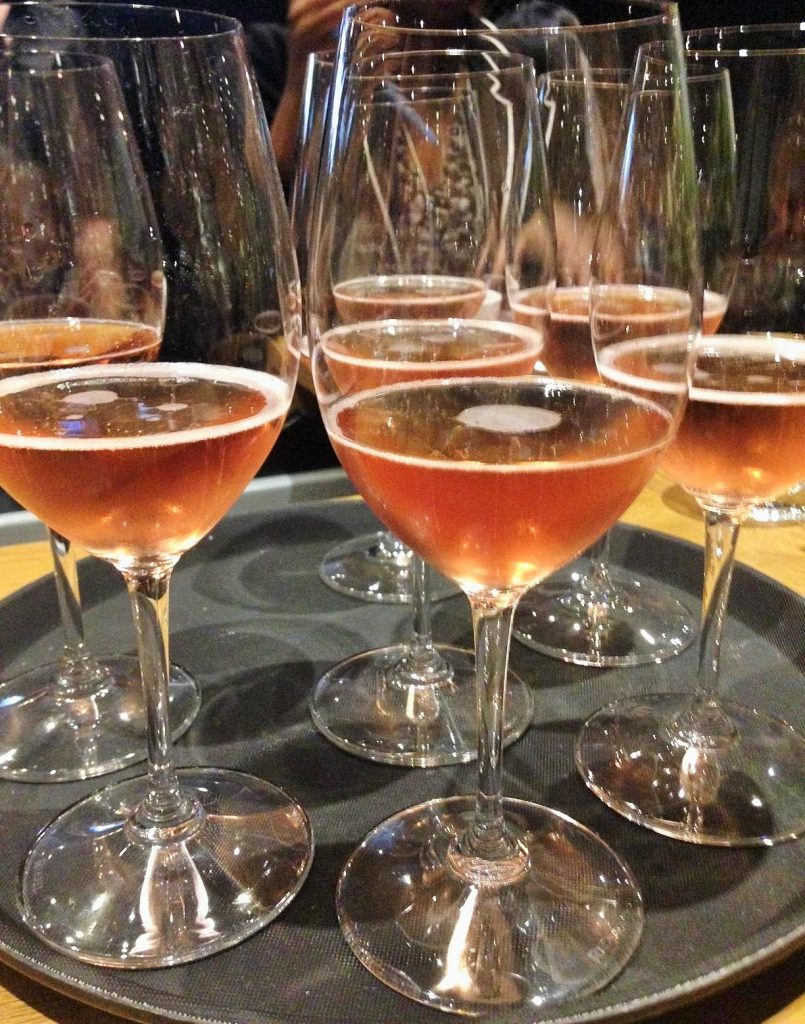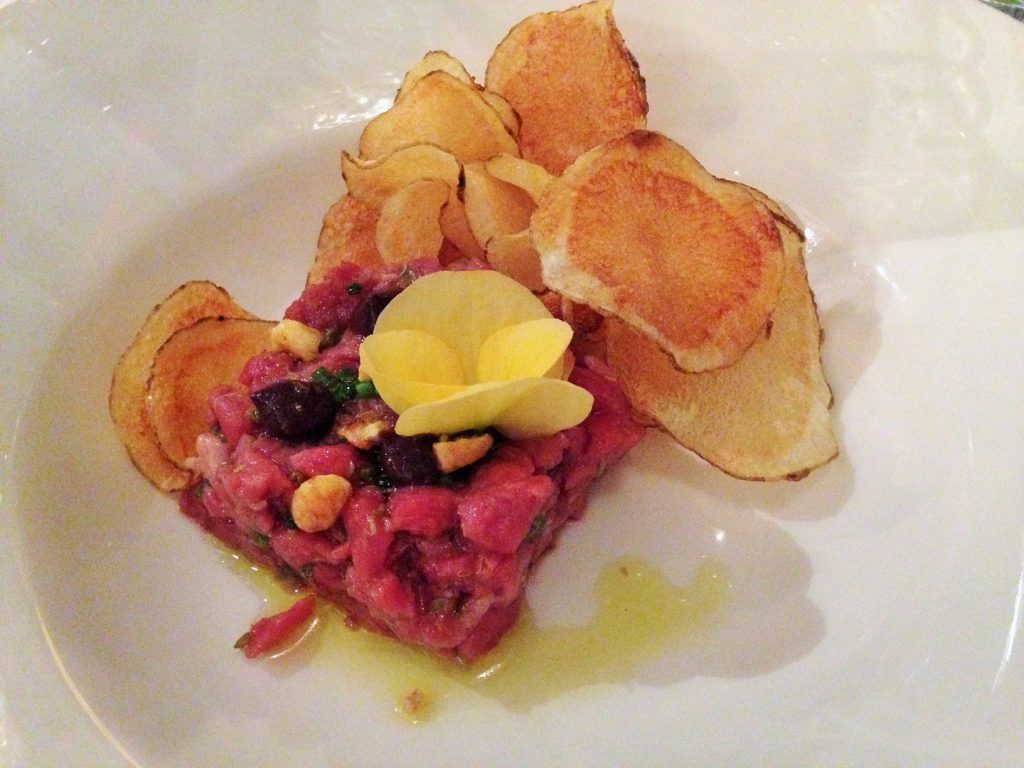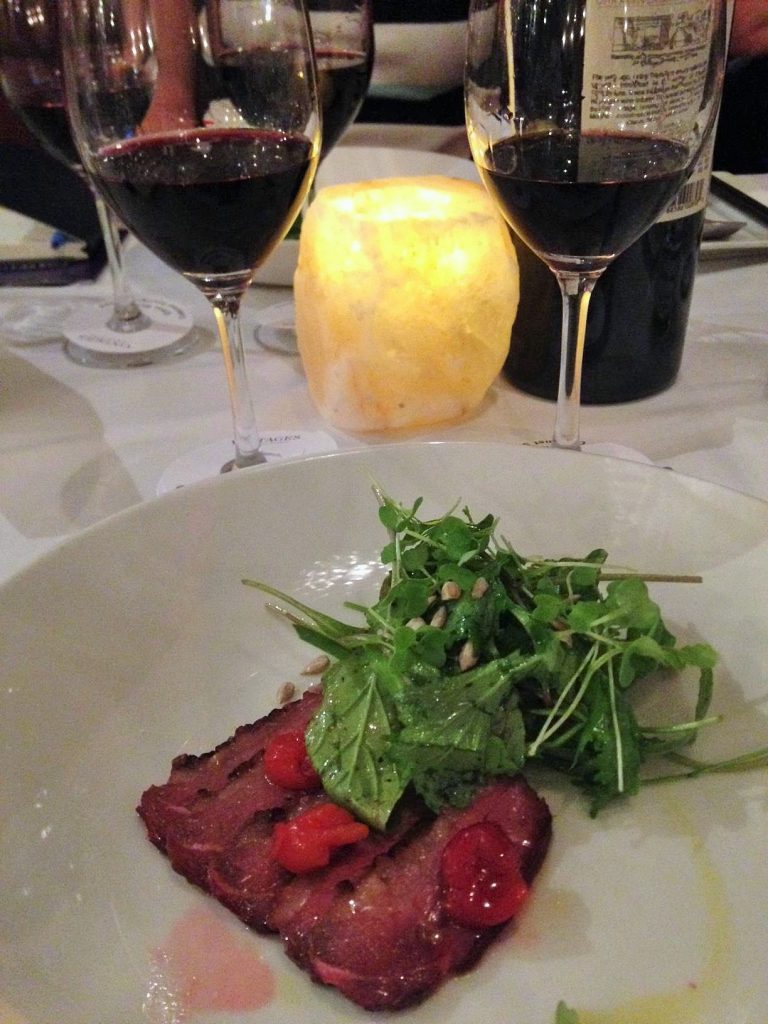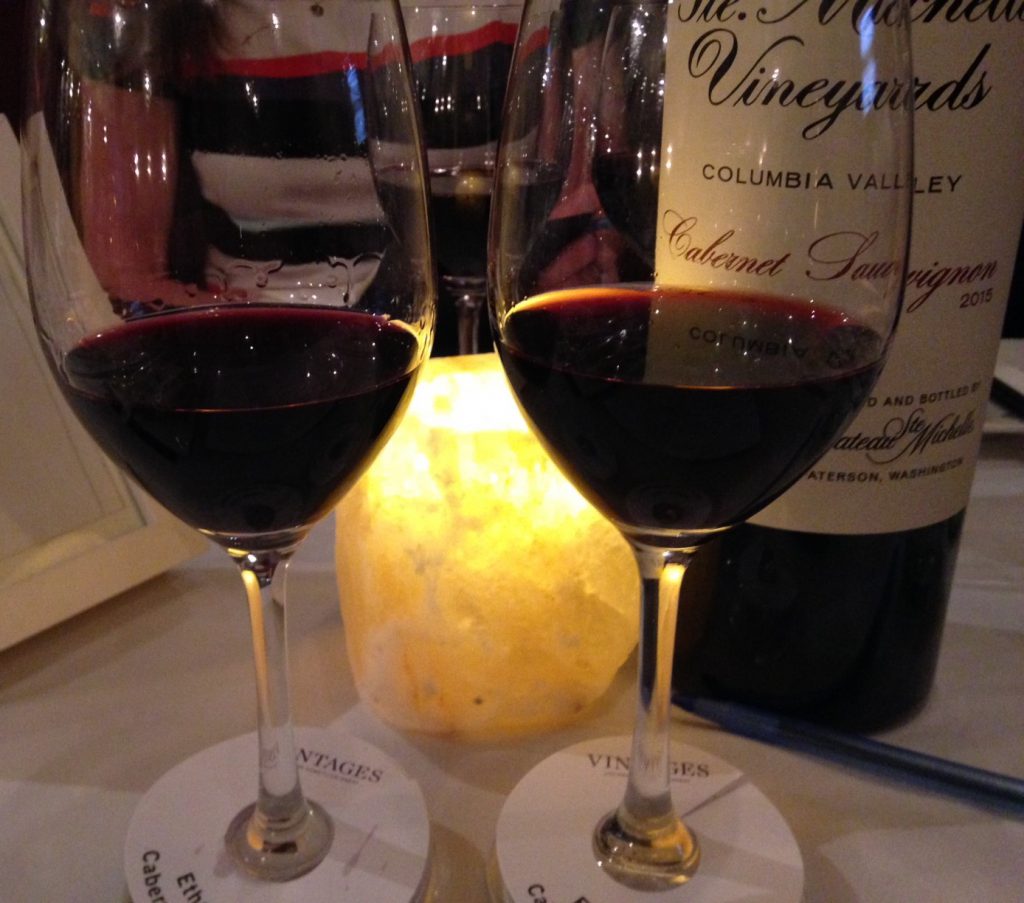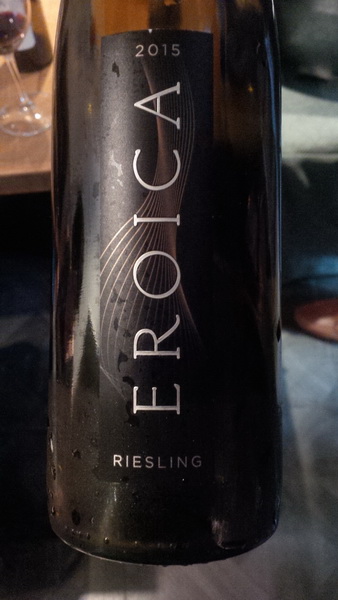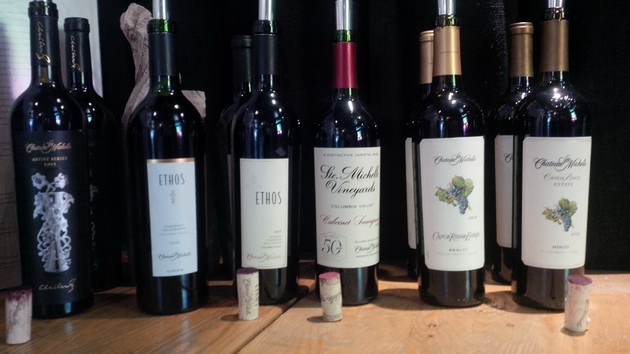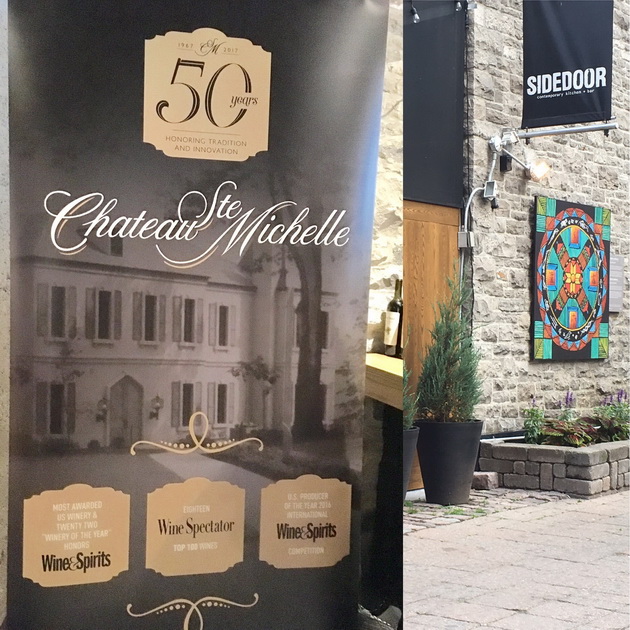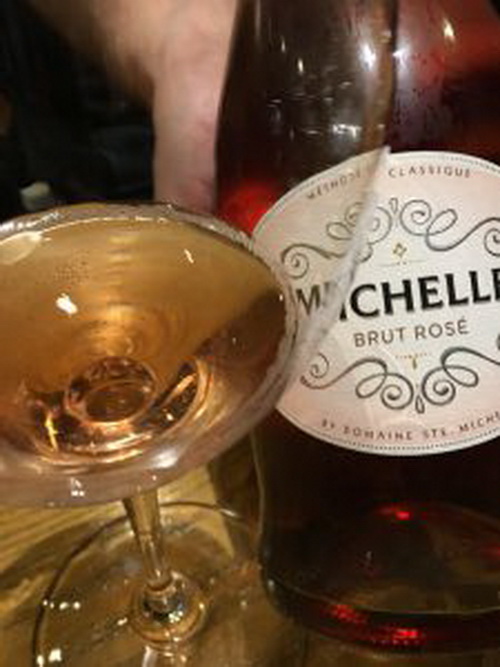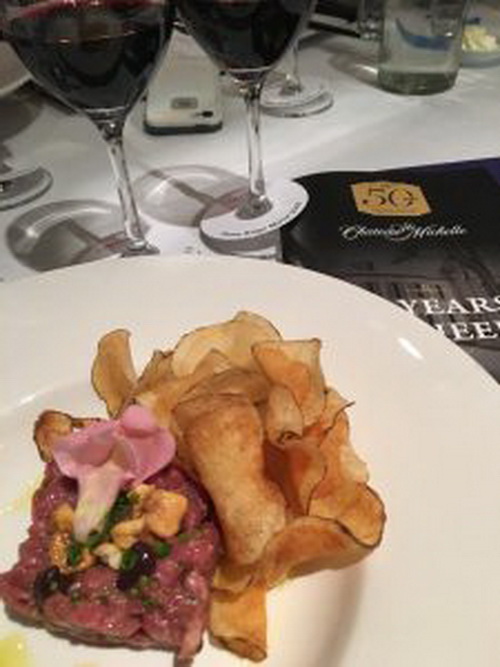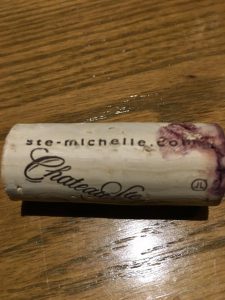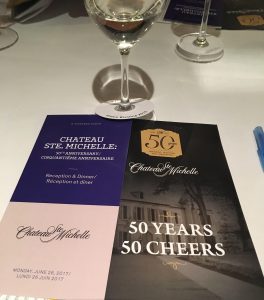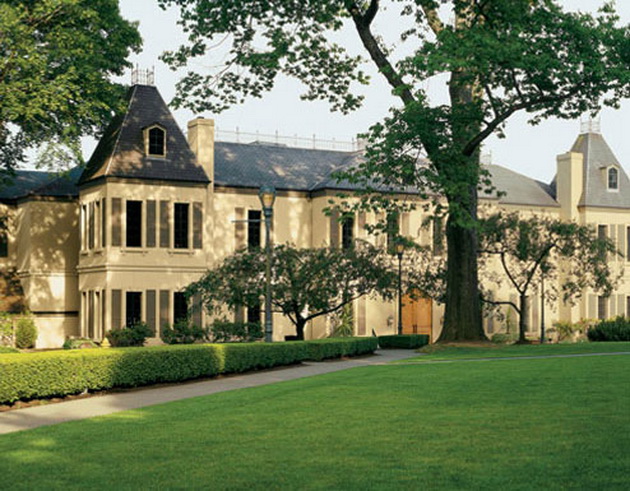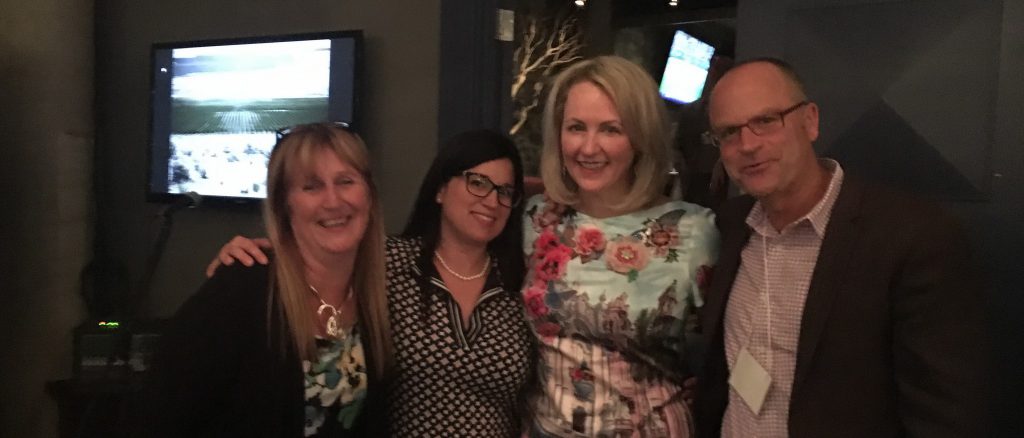Yesterday, Canada’s top writers and sommeliers gathered in our nation’s capital for two tastings with Chateau Ste. Michelle Head Winemaker, Bob Berteau.
These were historic tastings, with mature vintages drawn from the winery’s library, as well as new vintages in the market now (or soon).
It was also an historic first for a Facebook Live Video Winemaker Event in Canada, as we were joined virtually by many other wine lovers in real-time who were also able to ask Bob questions.
You can see a snippet of that live stream above by clicking on the arrow, and watch the complete wine tasting video live stream here. The audio is better on the native Facebook recording.
Stay tuned for our team observations, wine reviews, pictures and videos below.

Wine Columnist, Ottawa Citizen
A group of wine lovers, an enthusiastic and talented winemaker, and a beautifully paired meal – the ingredients for a wonderful evening!
Bob Bertheau, the head wine maker for Chateau Ste. Michelle wineries in Washington State, led us through an exceptional tasting of their portfolio, including several treasures from their cellar.
These elegant and very special wines were paired with a lovely meal prepared by the chef and staff of Sidedoor restaurant. Each course was planned to perfection, and in addition to enjoying the lovely wine and food, we had the pleasure of enjoying some stories from the winemaker to highlight each flight of wines.
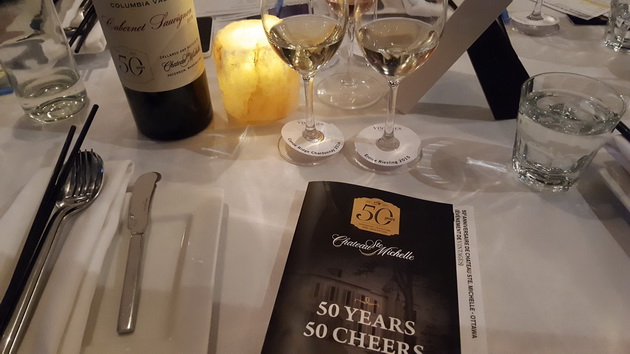 Photo: Jennifer MacDonald Havers
Photo: Jennifer MacDonald Havers
Nestled in the Columbia Valley, Chateau Ste. Michelle owns 3.500 acres of vineyards, including Cold Creek (first planted back in 1972), Canoe Ridge, and Horse Heaven. We had the pleasure of tasting selections from these vineyards.
Although many of us think of rainy Seattle when we consider Washington’s climate, Columbia Valley is protected by the Cascade Mountains. The resulting climate is surprisingly dry, and enables vintners to carefully control irrigation during the growing season.
Also unique to Washington wines is that due to their desert-like climate, their vines are able to be grown on their original vinifera rootstock. They do not have the same issues with the phylloxera pest that most other wine growing regions of the world endure.
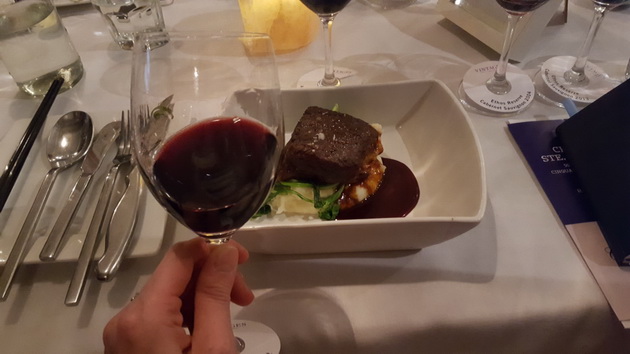 Photo: Jennifer MacDonald Havers
Photo: Jennifer MacDonald Havers
A special treat for this tasting was to be able to try some of the current premium wines with some of their older counterparts from these established vineyards, such as the 2013 Ethos Cabernet Sauvignon from the Cold Creek vineyards, alongside the 2004 version! What a great opportunity; the 2013 wines showed brighter fruit and more youthful tannin, but the 2004 showed more mature and pleasant dried fruit and herb characteristics.
Also, something I had not realized was that they make icewine! Made from Riesling, in a collaboration with a German winemaker, this was a real surprise, and even a room full of Canadians were all impressed!
50 years of tradition is always something to celebrate, but as a North American winery, they are clearly one of the pioneers in a relatively young history. It’s a real treat to try and enjoy these wines, and it’s exciting that more and more are becoming available in Canada.
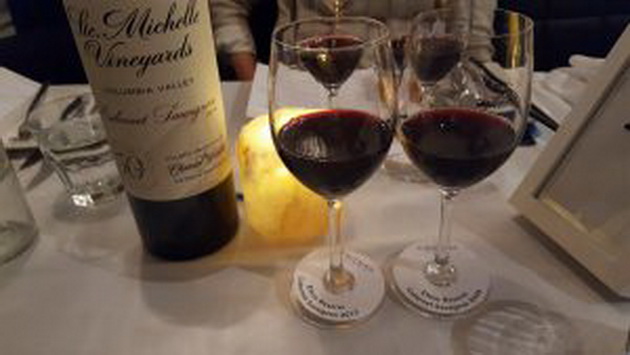 Photo: Jennifer MacDonald Havers
Photo: Jennifer MacDonald Havers
These wines all showed consistently high quality, and as well, we were able to see a glimpse into their ability to age, a sign of many more great years and great wines to come. Fifty years of tradition is always something to celebrate, but as a North American winery, they are clearly one of the pioneers in a relatively young history.
Columbia Valley, Washington State, United States

Greg Hughes
Wine Writer & Sommelier
On Monday, June 26th, we had the pleasure to celebrate Chateau Ste. Michelle’s fiftieth anniversary with their head winemaker, Bob Bertheau.
Bob, who has been with Chateau Ste. Michelle since 2003, takes the winery’s old-world character to heart. This contrasts the other major offering of the Ste Michelle portfolio, Columbia Crest (along with H3), which embraces its new-world profile.
Chateau Ste. Michelle has a rustic charm that comes from more traditional clone choices and details at harvest (grape shading, early/late harvesting etc…).
He built his reputation with Hambrecht, Hanzell, Chalk Hill, and even with wine-giant Gallo. His experience and perspective serve him well with the Ste. Michelle umbrella.
The land under vine was never developed with the intention of making bulk wine. It would be too expensive and wouldn’t be able to compete for volume with Central Valley California.
That being said, Chateau Ste Michelle is sizeable. It produces some fantastic values across mid (<$20) to high(>$50) priced categories. The way Bob puts it, how could they not make quality wine if the company owned such a large portion of available fruit in Washington? Astonishingly, 6/10 grapes grown in Washington belong to the Ste. Michelle wine group.
Experimentation still forms a big part of what Bob wishes to accomplish with Chateau Ste. Michelle. Some of the best wine styles in the world, not to mention fermentation itself, were all discovered by accident. After one season, Bob had forgotten to pick one tiny block of Chenin Blanc.
Instead of wasting the fruit, Bob decided to make wine with it anyway. It became botrytized on the vine and turned the wine into something unique which they haven’t made since, but which was special nonetheless.
It might interest a Canadian wine audience to know that the West-Coast wine States, all have their answers to icewine. Oregon and Washington both have late-harvests as well as icewines.
Bob firmly believes in the use of Riesling for Washington icewine/late harvest wines. It achieves super high levels of ripeness, but retains acidity because of diurnal coolness in the vineyards.
These are early days in the progressive ascension of Washington State’s global wine reputation. Your future self will resent you for not trying incredible underpriced wines that will undoubtedly be more expensive in the future.
Chateau Ste. Michelle Chardonnay 2016
Columbia Valley, Washington, United States

Wine Columnist, Ottawa Wedding Magazine
This year, Washington State’s Chateau Ste. Michelle Winery is marking their 50th anniversary.I recently gathered with a small group of Wine Writers to celebrate their fine wines with Head Winemaker, Bob Bertheau. Bob came to winemaking by the unusual route of first studying chemistry and pre-Med at university, obtaining an MS in Food Science and Enology from University of California at Davis.
After a stint in retail, he decided to change his career and mentored with several California winemakers before returning to his home state of Washington. He also has collaborated with Germany’s Ernst Loosen for the Eroica Riesling, from whom Bob learned the importance of pure fruit expression in the wine.
Washington has an excellent climate for growing grapes and since phylloxera is not a concern, all vines in Washington are planted on their own rootstocks.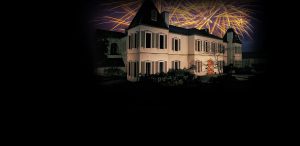
Today CSM owns estate vineyards on 3500 acres in the Columbia Valley, including Cold Creek, Horse Heaven and Canoe Ridge. They are best known for award-winning Riesling, Chardonnay, Merlot and Cabernet Sauvignon.
Bob’s goal as winemaker is to showcase the varietal character of Washington grapes, while reflecting the individual fruit expression of the different vineyards.
Our tasting, indeed illustrated the fine fruit expression in both the whites and reds.
With the Merlots, Cab Sauvs and Meritages, we compared recent vintages with those of ten years earlier to study the evolution of the wines. It was immediately evident how well-structured these wines are, with their stunning aromatics, harmonious flavours and excellent aging potential.
It was hard to pick a favourite, but I rated the Artist Series Meritage 93 points for both the 2003 and the 2012. The many awards given by Wine Spectator, Wine Enthusiast and Wine Advocate reflect the excellence of this series.
In 2016, CSM was named U.S. Producer of the Year in the International Wine & Spirits Competition. They are the most awarded U.S. winery. So let’s toast Chateau Ste. Michelle – evidently they have lots to celebrate!
Horse Heaven Hills, Washington, United States

MBA Professor, University of Ottawa & Wine Writer
On June 24 I had the chance to attend a tasting hosted by Chateau Ste Michelle’s head winemaker, Bob Bertheau.
Chateau Ste. Michelle is celebrating its 50th anniversary and the first thing I learned about the winery is that it is only one year younger than Napa’s famous Mondavi winery. CSM can brand itself the pioneer of Washington State wine.
Bob described Walter Klore as the “godfather of Washington State Vinifera”. Walter felt the climate, amount of day light, sandy soil and good access to water would make excellent conditions for grape growing.
Bob also emphasised that a successful future in winemaking involves getting the right varietals, the context of soils and temperature, pointing to the predominance of white wine such as Riesling, in the Ancient Lakes region of the Columbia Valley.
CSM first planted their Cold Creek Vineyard in 1972, which consisted on 500 acres. Today Cold Creek Vineyard is one of the oldest and most acclaimed vineyards in Washington State and along with Horse Heaven and Canoe Ridge Estate, forms CSMs three vineyards consisting of 3500 acres.
Bob described how the terroir of Washington State provides elements of both new world and old-world vineyards. The latitude resembles old-world, while the climate resembles new world.
Bob described how CSM has four basic tiers of wines: Columbia Valley, Indian Wells, Single Vineyards and Ethos. The differences across the tiers were showcased during the tasting.
The Columbia Valley line produces great value everyday drinking wine, whereas the single vineyard wines will have more complexity. An example from the tasting is the 2016 Chateau Ste. Michelle Chardonnay (Columbia Valley line) vs. the 2014 Chateau Ste. Michelle Canoe Ridge Chardonnay.
The Columbia Valley Chardonnay had soft flavors of oak and some spiced apple. Bob described two goals he has for this wine. One, to not make it too complicated and two, for people to want another glass of it.
In contrast, the Canoe Ridge Chardonnay was more old world style, with crisp and clean apple flavors with some fresh citrus notes. CSM makes a chardonnay to please all palates.
I always enjoy the chance to try the Eroica Riesling and the 2015 vintage did not disappoint with its lime and petrol notes along with some great minerality on the palate.
The red wines presented similar variations in taste and complexity. We had the chance to try the 2004 Ethos Reserve Cabernet Sauvignon, which was Bob’s first red vintage after becoming winemaker. It presented dark fruit, chocolate and stewed plum notes, in contrast to the 2013 Ethos vintage, which had more firm dark fruit flavors with some soft floral notes.
Bob stated that vinology programs teach you how not to make bad wine, but to make great wine you have to work with people and grapes. He has clearly mastered that ability given the success that Chateau Ste. Michelle has had over its 50-year history.
I look forward to many more great vintages from Bob.
Columbia Valley, Washington, United States
I had the pleasure of attending a structured tasting that Vintages/LCBO ran in Ottawa recently to mark the 50th anniversary of Chateau Ste. Michelle, the impressive Washington-based winery. Chateau Ste. Michelle’s head winemaker, Bob Bertheau, led the tasting of a few flights of their premium wines, including a few back vintage library wines from the early to mid 2000s, which was a great way to appreciate how their wines evolve after a decade + of cellar aging.
I was very impressed with their Eroica Riesling 2015 vintage. Eroica, meaning heroic or champion, is also the name of the third symphony that Beethoven composed originally as a tribute to Napoleon. Regardless of the name, it is a very expressive German-inspired Riesling with Washington terroir attributes, that makes it a fine example of a unique and ultra premium Riesling that Chateau Ste. Michelle produces in partnership with Dr. Loosen of Germany.
The Canoe Ridge Merlot (2013 and 2005) were superb high value wines, with old world attributes complete with the added complexities derived from their north west USA heritage. The Ethos Reserve Cabernet Sauvignon 2013 and 2004, when tasted beside each other, were so impressive with their dark fruit and spice characteristics, that had aged beautifully over a decade to produce a lovely bouquet and flavour profile of dried dark fruits with great structure. Absolutely gorgeous Washington Cabernet Sauvignon that any Cab-lover would fine incredibly attractive, even if you’ve never tasted a Washington Cab before.
The Artist Series Meritage, 2012 and 2003 were simply incredible. I’m always impressed with the unique style of Washington wines that clearly benefit from Washington’s hot and long days with its cool nights, which allows their grapes to achieve a high degree of ripeness while retaining the bright core of acidity that can often be lacking in other warm climate wine regions.
The level of richness and freshness speaks to the great balance they’ve achieved, and that is where the magic in Washington’s grape growing climate resides, in its ability to produce such ripe and refreshing wines that retain that beautiful harmony even after a decade of bottle aging. Very impressive.
When I hear people mention how Washington wines remind them of a unique blend of Napa and Bordeaux, I’d agree that Washington reds do show certain Napa and Bordeaux traits in terms of quality and styles, but it’s wineries like Chateau Ste. Michelle that have done a great job showcasing to the world how they make wines in their own unique Washington style, and how they’ve been excelling with that mission now for 50 years, so perhaps it’s best to describe those wines for what they are, purely Washington in style and quality.
If you do see some of the premium Chateau Ste. Michelle wines being released in Vintages in the coming months, I’d highly recommend picking up some and enjoying some now and cellaring some for 10+ years so you too, can enjoy just how delicious those wines are, both now and in the future.
Columbia Valley, Washington, United States
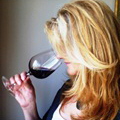
Tania Thomas
Wine Expert, Rogers Daytime Television
Our small team of wine writers had a unique opportunity to join in on a celebration of Chateau Ste. Michelle, Washington States Founding Winery’s 50th Anniversary. This exclusive five course dinner event was organized by Vintages and hosted by Chateau’s passionate winemaker, Bob Bertheau. The event was held at Ottawa’s Sidedoor Contemporary Kitchen & Bar in Byward market with Chateau’s premium wines, perfectly paired by Sidedoor’s Executive Chef, Ben Landreville.
For half a century the winery have combined Old World winemaking traditions with New World innovation. What makes Chateau Ste. Michelle unique is owning two state-of-the-art wineries, one for white wine production (Chateau in Woodinville) and one for the reds (Canoe Ridge Estate).
Ideally situated in Columbia Valley AVA, the winery’s 3,500 acres of vineyards are shielded from excessive rainfall by the Cascade Mountains, delivering more sunshine and enabling the berries to fully ripen producing fruit-forward, complex and elegant wines.
The first course was a beautifully presented plate of local asparagus with cured ham drizzled with lemon-Dijon dressing, perfectly matched with Eroica Riesling 2015 and Canoe Ridge Chardonnay 2014. Following, was the Beef Tartar with corn nuts, purple mustard and home-made potatoe chips, accompanied by Canoe Ridge Merlot 2013, and a smooth and velvety 2005 vintage.
The evening continued with the third course of roasted duck breast with sour cherry, local greens and sunflower seeds, paired by Ethos Reserve Cabernet Sauvignon 2013 and 2004, with layers of ripe dark berries and silky, mellow tannins.
My favourite course that followed was melt-in-your-mouth braised short rib with whipped mashed potatoes and rapini, in a most delicious jus. The wines served were Artist Series Meritage 2012 and 2003, bursting with aromas and flavours of ripe black cherries with a subtle touch of spice.
The conclusion of this delightful evening was a delectable local cheese board, paired with Eroica Riesling Icewine 2013, with luxurious and luscious mouthfeel and aromas of ripe apricots and honey. This was a perfect ending to a perfect evening. Thank you Chateau Ste. Michelle and cheers to another 50 awesome years of winemaking.
Chateau Ste. Michelle Chardonnay 2014
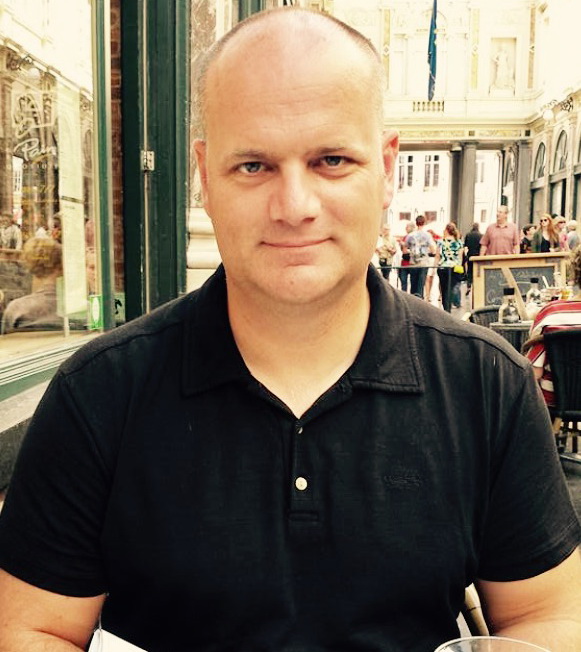
John Masur
Sommelier & Wine Writer
Head Winemaker Bob Bertheau, from the famed Chateau Ste. Michelle Winery of Washington State, visited Ottawa on Monday June 26th in honour of its 50th year as a winery. Back in 1967, just one year after Robert Mondavi started his winery in Napa, winemaker Andre Tchelistcheff, and Walter Clore (the ‘godfather’ of Washington State wine) planted about 50o acres of vineyards in Cold Creek to start Ste. Michelle Vitners.
This doubled the number of acres under vine in Washington State and helped establish the present day winery as Washington State’s largest.
Don’t presume for a moment that their northernly location, limits their ability to grow some of the finest red varietals that are familiar to consumers of California wines. Growing the fruit is only half the battle. The difference is when that fruit is in the hands of a skilled winemaker (Bob Bertheau on the right in the photo below).

Photo: John Masur
Thanks to the rain shadow of the Cascade mountains, the Columbia basin only receives about 8 inches of rainfall every year. This allows wineries like Chateau Ste. Michelle to manage their vineyards through irrigation in the sandy soils which resist the phylloxera aphid known to destroy the root stock of Vitis Vinifera grapes, the grapes that produce wine.
While the majority of vineyards around the world (especially in Europe) need to graft their Vitis Vinifera vines with root stock that is resistant to phylloxera, this is not necessary at Chateau Ste. Michelle. Nearly 100% of all grape vines planted (save for some involved in research), have original Vitis Vinifera roots. Most of the wines you have in your cellar, or drink everyday, may not have this type of pedigree.
This is yet another aspect that sets Chateau Ste. Michelle apart from other wineries. This is noticeable in the quality of the wines tasted.
Winemaker Bob Bertheau states “I won’t attend a winemaker’s dinner if it doesn’t feature the Eroica Riesling”.
Considering they are the #1 seller of Riesling in the United States ‘by far’, you can hardly blame him. It is their signature wine and it can be paired with any course or dish you can imagine.
After the wonderful Brut Rosé with its strawberry essence and mousse-like effervescence, our first flight of white wines started with the Eroica Riesling 2015. Crisp acidity matched with pleasant fruitiness of lime, grapefruit, and a honeyed finish. The wine is in complete balance along with a 13 g/L residual sugar that not one of the skilled tasters present could detect.
It’s not easy to become a ‘King of the Category’, but Chateau Ste. Michelle has achieved this and the seemingly dry finish of the Eroica Riesling (90/100) is sought after by Restauranteurs and Sommeliers for its ability to easily pair with so many foods.
Immediately after the Riesling, we were treated to two Chardonnays that demonstrated the diversity of the grape from a wonderfully tropical and fruity offering in its Throwback 50th Anniversary Label (50-50 barrel fermented and stainless steel, 89/100) to the Canoe Ridge Chardonnay (90/100) which displayed a higher acidity, apple, apricot and fresh fruit approach.
Oh, then there were the reds.
In two successive flights, we tasted the Canoe Ridge Merlot (2013, and 2005), the Cabernet 50th Anniversary Throwback Label 2015, the Ethos Cabernet Sauvignon (2013, and 2004), and the Artist Series Meritage (2012, and 2003).
Chateau Ste. Michelle has the advantage of long summer sunshine hours and sufficient ripening to bring the main red varietals (Cabernet Sauvignon, Merlot, Malbec, Petit Verdot) into focus for these wines.
Bob’s philosophy of winemaking straddles both New World and Old World styles, but that is determined by how the fruit best expresses itself. For a New World example, the Ethos 2013 Cabernet Sauvignon is picked mostly from the Cold Creek vineyard which is characteristically fresh and bold, ripe red fruit, deep colour, chocolate, with very fine tannins and a long finish which I rated at 91/100 points.
In the highpoint of the tasting I would point to the Artist Series 2003 Meritage with its deep garnet colour and aromas of dried dark fruits, black pepper, tobacco and chocolate. The sublime combination of acidity, powdery tannins, and fruit blended delicately into the opulent long finish of blackberries and cherry.
Nothing dominates, it all comes together seamlessly. This wine is a great example of the longevity tasted in the older wines as it was agreed these could easily go several more years in the cellar, on their way to greater potential. I gave the 2003 Meritage the highest score of the tasting at 94/100 points.
Beyond the vines and the wine, Bob Bertheau and Chateau Ste. Michelle, are proponents of wine research and their affiliation with the educational institutions within Washington State that have wine as a focus. They actively support the Wine Science Centre at Washington State University, its Viticulture & Enology Program, and the Chateau Ste. Michelle Scholarship Fund for under-represented minority undergraduates at WSU and University of Washington.
Chateau Ste. Michelle Canoe Ridge Merlot Columbia 2013
Columbia Valley, Washington, United States
Lise Gagne
Wine Writer
Winemaker Bob Bertheau caught my attention when asked about oak influence. His answer was “Oak is like frosting on a cake”. As a new wine writer for Natalie I thoroughly enjoyed the wonderful meal at Sidedoor restaurant in Ottawa to celebrate Chateau Ste Michelle’s 50 year anniversary.
Although it was my first winemaker event I felt completely at ease with Bob and his team. Bob described his winemaking approach in a “keeping it real” format while leading us through the 5 decades of rich wine making highlights and the current grass roots company vision.
Photo: Lise Gagne
Bob describes his winemaking journey as learning how not to make wine in many wineries with many mentors along the way. I instantly related on the importance of having a mentor and being a mentor.
Photo: Lise Gagne
Chateau Ste Michelle (CSM) is heavily engaged in the local collaborative efforts of many other small wineries in the area with the ultimate goal to showcase, promote and support the success of all. He described these efforts as a tight knit society to raise the bar and support scientific studies to best express the states fruit. It’s obvious why CSM is the “big guy” of the area and Bob indicated they are similar to the roots of the tree there to support the smaller branches.
Photo: Lise Gagne
What does five decades of wine making look like? CSM started planting vines in the early 1970’s during the funky bell bottom decade. The early pioneers planted the Cold Creek vineyard banking on the desert climate, extra sandy soil and access to tons of water from the valley.
Photo: Lise Gagne
Although the Columbia valley is approximately 200 km in any given direction the different growing conditions allow for “Not specific viticulture”. In the spirit of the past CSM is introducing a throwback label for the Cabernet Sauvignon 2015, Riesling 2015 and Chardonnay 2016 this year – watch out for them (the wine will be the same).
Photo: Lise Gagne
The evening had an incredible vibe and I tasted nine wines. To my surprise CSM showcased a Rose, a Riesling and a Chardonnay – I wasn’t aware they made anything other than big bold reds. To my delight we tasted 6 reds of which two were back vintages. It was a real delight to compare cellar stock to recent or upcoming releases and explore what ten years of cellar time can do.
CSM definitely makes some big beefy reds that are approachable now and worthy of some serious cellar time. They have four tiers of wines. The Columbia Valley at the lowest price point, Indian Wells grown in the Golden Slope with a new world jammy style, three Single Vineyard lines and the Artist Series.
Photo: Lise Gagne
I walked away from the experience with some insight on the growing conditions, terroir and CSM’s commitment to Washington wine making. The outcome is clear to me, they make a range of delicious ready to drink wine all the way to multiple types of high quality cellar worthy wines.
As a big Merlot drinker I was very interested to learn that they blend Cabernet Sauvignon to the Merlot (Canoe Ridge Merlot) to soften the Merlot. The conditions (hot summers and cold fall) transmit to the Merlot grapes retaining more than usual fresh tannins.
Photo: Lise Gagne
My favorite wine was the 2003 Artist Series Meritage a blend of Cabernet, Merlot, Malbec and Petit Verdot. The reasoning behind the blend simply stated was they wanted to taste a Statement versus the individual varieties. Statement heard CSM, it’s pretty uncomplicated I do want another glass right after the first one!
Photo: Lise Gagne
Chateau Ste. Michelle Ethos Reserve Cabernet Sauvignon 2004
Columbia Valley, Washington State, United States

Editor, Ottawa Wine Journal
I was first drawn to Washington wine after drinking excellent vintages of Quilceda Creek in the mid-2000s while living in Halifax. My friend, who was also a significant private collector also introduced me to L’Ecole 41 wines and, one of his favourite wines under $30, the excellent Chateau Ste. Michelle Indian Wells Merlot.
I fell in love with the plush textures of Washington wines while consumed young, and their incredible, Bordeaux-like ageability, especially in their higher end wines. Pound for pound Washington wine can be thrown against some of the greatest wine regions of the world – but for a lot less money.
The tasting with Bob Bertheau from Ste. Michelle was a great insight into the diversity and complexity of Washingon wines. Let’s make no mistake, Ste. Michelle dominates the Washington wine scene in terms of volume production, but there is something different about their wine philosophy. As Bertheau points out in the session, a strong, diverse, and well-supported group of producers is good for everyone in Washington, and Ste. Michelle believes it has a role in supporting the little guys to ensure the success of the State’s wine scene for years to come.
Because of lower fruit costs, Washington packs a serious value punch. Even the top wines in the State do not fetch the same dollars as their California counterparts. What you have then is an incredible source of world-class wines that you might venture to buy 6-12 bottles of, rather than 2 or 3.
A case in point is the 2005 Canoe Ridge Merlot, a wine that shows incredible grace 12 years past its birthday. At $54, I would throw it against of the best riper year Right Bank Bordeaux at triple the price in a blind tasting and would favour my changes. The Ethos wines were equally ethereal, with incredible pure fruit, herbs and milk/dark chocolate flavours wrapped around taut, minerally cores. The ripe fruit is balanced by delightful acidity, making the wines almost dance on your tongue.
Similarly, the white wines showed incredible balance of freshness and fruit flavours ranging from ripe tropical to unripe stone fruit and citrus. The Eroica Riesling was equally scintillating, reinforcing the State’s incredible penchant for the grape.
The lineup of wines was superb, and more importantly, eminently affordable for the average consumer. Bertheau’s passion for winemaking and the state were evident. More importantly, the philosophy of looking out for one’s neighbour wineries goes a long way in promoting diversity in winemaking. The best is yet to come for Washington wines, as evidenced by its flagship producer.
Chateau Ste. Michelle Ethos Reserve Cabernet Sauvignon 2013
Columbia Valley, Washington State, United States
Lori Kilmartin
Sommelier & Wine Competition Judge
Bob Bertheau, Head Winemaker at Chateau Ste Michelle since 2003, entertained and regaled an enraptured crowd at a special Wine and Food event at the Sidedoor Restaurant in Ottawa this week. I was fortunate to be one of those in attendance.
The event was held to honour the fine wines that have been produced at Chateau St. Michelle since 1967. The wines showcased ranged from the 2015 Eroica Riesling to a 2003 Artist Series Meritage. In all 9 wines were tasted, and each was paired with some delicious food from Chef Landreville at Sidedoor.
It was interesting to hear how the first Vintage made in 1967 (Cabernet Sauvignon) was one of the earliest Vinifera wines produced in North America (Robert Mondavi in Napa just one year earlier). Today Chateau Ste. Michelle is Washington State’s oldest and largest winery with four different vineyard locations: Columbia Valley, Canoe Ridge Estate, Cold Creek Vineyard and Horse Heaven Vineyard.
It was really thought provoking to see the pictures and hear how over 12 million years ago, a river of lava carved out what is now known as Canoe Ridge. This created layers of basalt, which today are covered by free-draining soils that were left there by the great floods of the last Ice Age, about 13,000 years ago. Hearing about time frames like this, make a 50 year anniversary seem like a drop in a bucket!
Another noteworthy fact is that all the root stock for the vines is not grown on grafted roots because the climate makes the plants resistant to pests and molds. This is very different from most wineries throughout the world.
It was interesting to hear how the first Vintage made in 1967 (Cabernet Sauvignon) was one of the earliest Vinifera wines produced in North America (Robert Mondavi in Napa just one year earlier). Today Chateau Ste. Michelle is Washington State’s oldest and largest winery with four different vineyard locations: Columbia Valley, Canoe Ridge Estate, Cold Creek Vineyard and Horse Heaven Vineyard.
It was really thought provoking to see the pictures and hear how over 12 million years ago, a river of lava carved out what is now known as Canoe Ridge. This created layers of basalt, which today are covered by free-draining soils that were left there by the great floods of the last Ice Age, about 13,000 years ago. Hearing about time frames like this, make a 50 year anniversary seem like a drop in a bucket!
Another noteworthy fact is that all the root stock for the vines is not grown on grafted roots because the climate makes the plants resistant to pests and molds. This is very different from most wineries throughout the world.
I was fascinated to hear how Bob is collaborating with other Winemakers in different countries to refine and make the Chateau Ste Michelle wines even better. The Eroica 2015 Riesling that he and famed Mosel winemaker Ernst Loosen created is an excellent example of what can be produced when two winemakers put their head’s together. I also heard first-hand from Bob how he worked with France’s iconic Rhône winemaker Michel Gassier and Southern Rhône’s famous enology consultant, Philippe Cambie to produce a GSM blend and 100% Syrah under the “Tenet Wines” label. I will be watching the LCBO for releases from this combination of Old World and New world expertise which I think will produce some excellent and interesting wines.
What I really loved about the evening was the chance to taste some recent releases with some older vintages. We compared the 2013 Canoe Ridge Merlot with the 2005 Vintage and the 2012 Meritage with the 2003 Vintage. Of all the wines tasted during the evening this 2003 Artist Series Meritage; a classic Bordeaux blend of Cabernet Sauvignon, Merlot, Cabernet Franc, Malbec and Petite Verdot was my favourite. The fact that I ordered 3 bottles for my cellar is a testament to that!
So – while 50 years have gone by, Chateau Ste Michelle shows no sign of slowing down. If anything Bob Bertheau’s passion and energy is evidence alone that “the best is yet to come”!
Chateau Ste. Michelle Artist Series Meritage 2012
Columbia Valley, Washington, United States
Chateau Ste. Michelle Artist Series Meritage 2003
Columbia Valley, Washington, United States
Chateau Ste. Michelle Cabernet Sauvignon 2015
Columbia Valley, Washington State, United States
Chateau Ste. Michelle Eroica Riesling Vin De Glacière 2013
Columbia Valley, Washington, United States
Celebrate 50 years of greatness with Washington State’s founding premium winery.
This milestone-marking event featured top wines from Chateau Ste. Michelle, as well as Riesling and Icewine made in collaboration with famed Mosel winemaker Ernst Loosen.
For many, knowing the history and background of the wine inside the glass isn’t of the utmost importance. But, by coming here, you’re telling us you’d like to know a little bit more about who we are and what we’re all about. At Chateau Ste. Michelle, our award-winning wines interweave with our rich heritage to create a wine experience you’ll never forget.
1912: Built on the 1912 estate owned by Seattle lumber baron Frederick Stimson, the winery’s roots date back to the Repeal of Prohibition.
1967: In 1967 under legendary winemaker Andre Tchelistcheff, a new line of premium vinifera wines was introduced called Ste. Michelle Vintners.
1972: The first vines were planted at Cold Creek Vineyard in Eastern Washington in 1972.
1976: Four years later, Ste. Michelle Vintners built a French style winery Chateau in Woodinville, and changed its name to Chateau Ste. Michelle.
1991: Canoe Ridge Estate Vineyard planted in 1991.
2017: Since then, we have combined Old World winemaking traditions with New World innovation. In fact, Chateau Ste. Michelle is one of the few premium wineries in the world with two state-of-the-art wineries, one for red and one for white.
The whites are made at the Chateau in Woodinville, WA, while the reds are made at our Canoe Ridge Estate winery in Eastern Washington.
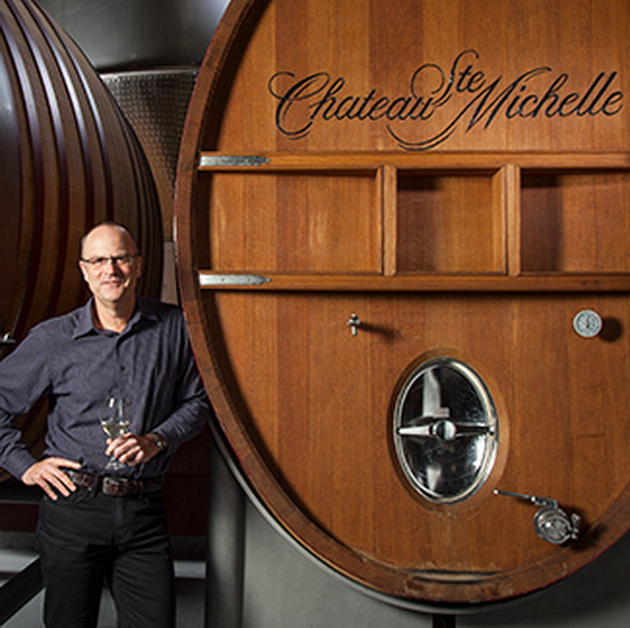 Bob Bertheau
Bob Bertheau
Chateau Ste. Michelle Head Winemaker
Bob has maintained Chateau Ste. Michelle’s legacy of crafting awarding-winning Chardonnay, Riesling, Merlot and Cabernet Sauvignon, while putting his own signature on the wines. “I have learned from Ernst Loosen, our German winemaking partner on Eroica Riesling, how to protect fruit purity and produce fresh, fruit-driven Rieslings.
“For Chardonnay,” Bob adds, “I’m using more Burgundian yeasts and have changed our lees stirring and oak regimes for better integration of oak flavors and more harmonious, soft Chardonnays. Washington’s red varieties have great structure and intense fruit. My goal with the reds is to harness the tannins for more accessible red wines from Chateau Ste. Michelle.”
Prior to joining Chateau Ste. Michelle, Bob made his mark at Hambrecht Vineyards and Wineries with their Belvedere and Bradford Mountain labels. In his formative years out of UC Davis, he gained valuable mentoring from such renowned winemakers as Bob Sessions at Hanzell Vineyards and David Ramey at Chalk Hill. Wanting to gain an even broader experience with a wide variety of grapes and viticulture areas, Bob also worked at Gallo of Sonoma for five years, helping to bring a smaller winery mentality to the larger facility.
For Bob, the move to Chateau Ste. Michelle in 2003 was not only the chance to make wine for one of Washington’s most acclaimed wineries, it was a chance to come home. He was born in Seattle, went to school in nearby Idaho, and has most of his family living in the Seattle area. Bob has a degree in chemistry from Boise State University and an MS in food science and enology from University of California at Davis.
Tickets to these two tastings were provided courtesy of Chateau Ste. Michelle.




